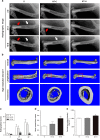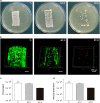Cytocompatibility with osteogenic cells and enhanced in vivo anti-infection potential of quaternized chitosan-loaded titania nanotubes
- PMID: 27672479
- PMCID: PMC5028847
- DOI: 10.1038/boneres.2016.27
Cytocompatibility with osteogenic cells and enhanced in vivo anti-infection potential of quaternized chitosan-loaded titania nanotubes
Abstract
Infection is one of the major causes of failure of orthopedic implants. Our previous study demonstrated that nanotube modification of the implant surface, together with nanotubes loaded with quaternized chitosan (hydroxypropyltrimethyl ammonium chloride chitosan, HACC), could effectively inhibit bacterial adherence and biofilm formation in vitro. Therefore, the aim of this study was to further investigate the in vitro cytocompatibility with osteogenic cells and the in vivo anti-infection activity of titanium implants with HACC-loaded nanotubes (NT-H). The titanium implant (Ti), nanotubes without polymer loading (NT), and nanotubes loaded with chitosan (NT-C) were fabricated and served as controls. Firstly, we evaluated the cytocompatibility of these specimens with human bone marrow-derived mesenchymal stem cells in vitro. The observation of cell attachment, proliferation, spreading, and viability in vitro showed that NT-H has improved osteogenic activity compared with Ti and NT-C. A prophylaxis rat model with implantation in the femoral medullary cavity and inoculation with methicillin-resistant Staphylococcus aureus was established and evaluated by radiographical, microbiological, and histopathological assessments. Our in vivo study demonstrated that NT-H coatings exhibited significant anti-infection capability compared with the Ti and NT-C groups. In conclusion, HACC-loaded nanotubes fabricated on a titanium substrate show good compatibility with osteogenic cells and enhanced anti-infection ability in vivo, providing a good foundation for clinical application to combat orthopedic implant-associated infections.
Figures








Similar articles
-
Inhibited Bacterial Adhesion and Biofilm Formation on Quaternized Chitosan-Loaded Titania Nanotubes with Various Diameters.Materials (Basel). 2016 Mar 3;9(3):155. doi: 10.3390/ma9030155. Materials (Basel). 2016. PMID: 28773281 Free PMC article.
-
In vivo evaluation of the anti-infection potential of gentamicin-loaded nanotubes on titania implants.Int J Nanomedicine. 2016 May 19;11:2223-34. doi: 10.2147/IJN.S102752. eCollection 2016. Int J Nanomedicine. 2016. PMID: 27274245 Free PMC article.
-
Inhibited bacterial biofilm formation and improved osteogenic activity on gentamicin-loaded titania nanotubes with various diameters.Int J Nanomedicine. 2014 Mar 7;9:1215-30. doi: 10.2147/IJN.S57875. eCollection 2014. Int J Nanomedicine. 2014. PMID: 24634583 Free PMC article.
-
Improved osteogenic activity and inhibited bacterial biofilm formation on andrographolide-loaded titania nanotubes.Ann Transl Med. 2020 Aug;8(16):987. doi: 10.21037/atm-20-4901. Ann Transl Med. 2020. PMID: 32953787 Free PMC article.
-
A review of TiO2 NTs on Ti metal: Electrochemical synthesis, functionalization and potential use as bone implants.Mater Sci Eng C Mater Biol Appl. 2017 Jul 1;76:1401-1412. doi: 10.1016/j.msec.2017.02.150. Epub 2017 Mar 3. Mater Sci Eng C Mater Biol Appl. 2017. PMID: 28482507 Review.
Cited by
-
GO/Cu Nanosheet-Integrated Hydrogel Platform as a Bioactive and Biocompatible Scaffold for Enhanced Calvarial Bone Regeneration.Int J Nanomedicine. 2024 Aug 14;19:8309-8336. doi: 10.2147/IJN.S467886. eCollection 2024. Int J Nanomedicine. 2024. PMID: 39161358 Free PMC article.
-
Biomaterial-assisted tumor therapy: A brief review of hydroxyapatite nanoparticles and its composites used in bone tumors therapy.Front Bioeng Biotechnol. 2023 Apr 7;11:1167474. doi: 10.3389/fbioe.2023.1167474. eCollection 2023. Front Bioeng Biotechnol. 2023. PMID: 37091350 Free PMC article. Review.
-
Optimisation of Lactobacillus fermentation conditions and its application in the fermentation of salt-free sauerkraut.Front Microbiol. 2024 Oct 21;15:1482163. doi: 10.3389/fmicb.2024.1482163. eCollection 2024. Front Microbiol. 2024. PMID: 39498136 Free PMC article.
-
Evaluation of the Cathodic Electrodeposition Effectiveness of the Hydroxyapatite Layer Used in Surface Modification of Ti6Al4V-Based Biomaterials.Materials (Basel). 2022 Oct 6;15(19):6925. doi: 10.3390/ma15196925. Materials (Basel). 2022. PMID: 36234265 Free PMC article.
-
Thermosensitive quaternized chitosan hydrogel scaffolds promote neural differentiation in bone marrow mesenchymal stem cells and functional recovery in a rat spinal cord injury model.Cell Tissue Res. 2021 Jul;385(1):65-85. doi: 10.1007/s00441-021-03430-x. Epub 2021 Mar 24. Cell Tissue Res. 2021. PMID: 33760948
References
-
- Court-Brown CM, Keating JF, McQueen MM. Infection after intramedullary nailing of the tibia. Incidence and protocol for management. J Bone Joint Surg Br 1992; 74: 770–774. - PubMed
-
- Chen CE, Ko JY, Wang JW et al. Infection after intramedullary nailing of the femur. J Trauma 2003; 55: 338–344. - PubMed
-
- Court-Brown CM. Reamed intramedullary tibial nailing: an overview and analysis of 1106 Cases. J Orthop Trauma 2004; 18: 96–101. - PubMed
-
- Birdsall PD, Milne DD. Toxic shock syndrome due to percutaneous Kirschner wires. Injury 1999; 30: 509–510. - PubMed
-
- Losic D, Aw MS, Santos A et al. Titania nanotube arrays for local drug delivery: recent advances and perspectives. Expert Opin Drug Deliv 2015; 12: 103–127. - PubMed
LinkOut - more resources
Full Text Sources
Other Literature Sources
Research Materials

